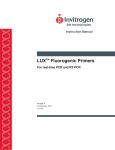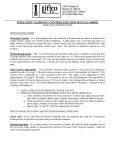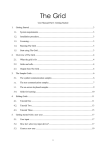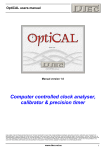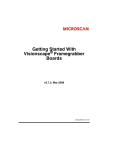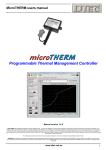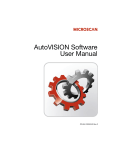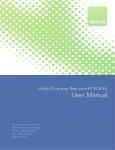Download ABI PRISM 7700 - Thermo Fisher Scientific
Transcript
Protocols LUX™ Primers Instrument Protocols For Using LUX™ Primers on the: ABI PRISM® 7700 Bio-Rad iCycler™ Corbett Rotor-Gene 3000™ DNA Engine Opticon® 2 ABI PRISM® 7900 Version B 17 March 2003 25-0696 Roche LightCycler® ABI PRISM® 7000 Cepheid Smart Cycler® Stratagene Mx3000P™ Instrument Protocols and Settings for LUX™ Primers Specific protocols have been developed for using LUX™ Primers on real-time qPCR instruments. These protocols all use Platinum® Quantitative PCR SuperMix-UDG, available from Invitrogen (Cat. nos. 11730-017 and 11730025). For real-time quantitative RT-PCR, we recommend the SuperScript™ III Platinum® One-Step qRT-PCR Kit (Cat. nos. 11732-020 and 11732-088). See the kit manual for a protocol using LUX™ Primers. Protocol Page ® ABI PRISM 7700.................................................................................................................... 2 Roche LightCycler® ................................................................................................................. 4 Bio-Rad iCycler™ ..................................................................................................................... 6 ABI PRISM® 7000.................................................................................................................... 8 Corbett Rotor-Gene 3000™ .................................................................................................... 10 Cepheid Smart Cycler® .......................................................................................................... 12 DNA Engine Opticon® 2......................................................................................................... 14 Stratagene Mx3000P™ .......................................................................................................... 16 ABI PRISM® 7900.................................................................................................................. 18 Trademark Information PRISM is a registered trademark of Applied Biosystems. LightCycler is a registered trademark of a member of the Roche Group. iCycler is a trademark of Bio-Rad Laboratories. Rotor-Gene 3000 is a trademark of Corbett Research. Smart Cycler is a registered trademark of Cepheid. Opticon is a registered trademark of MJ Research, Inc. Mx3000P is a trademark of Stratagene. 1 ABI PRISM® 7700 The following real-time quantitative PCR settings and protocol are designed for using LUX™ Primers on the ABI PRISM® 7700. See the LUX™ Fluorogenic Primers manual (available at www.invitrogen.com/lux) for more information and additional protocols. Master Mix Prepare a Master Mix as described below, then add template to each reaction as described in the protocol on the following page. The standard reaction volume is 50 µl. Monoplex reaction Component Platinum® qPCR SuperMix-UDG LUX™ labeled primer Unlabeled primer ROX Reference Dye Autoclaved distilled water Initial conc. 2X 10 uM 10 uM 50X — Single rxn (50 µl) 25 µl 1 µl 1 µl 1 µl to 40 µl 50 rxns (50 µl) 1250 µl 50 µl 50 µl 50 µl to 2000 µl Final conc. 1X 200 nM 200 nM 1X — Initial conc. 2X 10 uM 10 uM 10 uM 10 uM 50 mM 50X — Single rxn (50 µl) 25 µl 0.5 µl 0.5 µl 1 µl 1 µl 3 µl 1 µl to 40 µl 50 rxns (50 µl) 1250 µl 25 µl 25 µl 50 µl 50 µl 150 µl 50 µl to 2000 µl Final conc. 1X 100 nM 100 nM 200 nM 200 nM 3 mM* 1X — Multiplex reaction Component Platinum® qPCR SuperMix-UDG LUX™ labeled primer (1) Unlabeled primer (1) LUX™ labeled primer (2) Unlabeled primer (2) MgCl2 ROX Reference Dye Autoclaved distilled water *6 mM total Mg++, including MgCl2 in Platinum® qPCR SuperMix-UDG Cycling Program See the following page for tips and recommendations on programming the ABI PRISM® 7700. Recommended Action UDG reaction UDG inactivation/template denaturation Denaturation Hybridization /Elongation Melting curve analysis Temp (°C) 50 95 95 60 60–95 Time 2 min 2 min 15 sec 30 sec Cycles 1 1 Temp (°C) 50 95 95 55 72 60–95 Time 2 min 2 min 15 sec 30 sec 30 sec Cycles 1 1 40–50 Ramp time Acquisition Yes Yes Yes Yes 19 min In the ramp Alternative Action UDG reaction* UDG inactivation/template denaturation Denaturation Hybridization Elongation Melting curve analysis *Uracil DNA glycosylase-mediated carry-over prevention Continued on the next page 2 40–50 Ramp time Acquisition Yes Yes Yes Yes Yes 19 min In the ramp Protocol 1. Program the ABI PRISM® 7700 as shown in the cycling program. Optimal cycling temperatures and times may vary for different target sequences and primer sets. 2. Prepare a master mix of all components except template as specified. Note: Preparation of a master mix is crucial in quantitative applications to reduce pipetting errors. 3. For each reaction, add 40 µl of the master mix to each tube, strip well, or well of the qPCR plate. 4. Add 10 µl of sample template (100 pg to 1 µg of genomic DNA, or cDNA generated from 1 pg to 1 µg of total RNA) to each reaction vessel and cap or seal the tube/strip/plate. 5. Gently mix and make sure that all components are at the bottom of the tube/well. Centrifuge briefly if needed. 6. Place reactions in the thermal cycler programmed as described above. Collect and analyze the results. Tips and Recommendations for Programming the Instrument Follow the instructions in the ABI PRISM® 7700 user manual to program the instrument and analyze results. The following are tips and recommendations for programming the instrument: • Choose the Single Reporter plate format when opening a new plate to read. • To set up the plate, define all of the wells that contain reactions and then select the appropriate Dye Layer (FAM or JOE) for each Sample, Standard, or NTC. • Note that as long as you select a well with at least one dye, you can always change the dye layer parameter after analysis. Unselected wells will not be read. • You can manually choose the cycling Threshold setting in the Amplification Plot after a reading. • By default, the baseline Start Cycle is 6 and the End Cycle is 15, but you should change these to reflect the actual baseline of your specific amplification profile. • To analyze the melting curve, go to the File menu and select Export > Multicomponent to create a multicomponent file. Then open the multicomponent file using the Dissociation Curve software program from ABI. Additional Products Product Catalog number Size Platinum® Quantitative PCR SuperMix-UDG 11730-017 11730-025 100 reactions 500 reactions 11732-020 11732-088 100 reactions 500 reactions (includes separate tubes of ROX Reference Dye and MgCl2) SuperScript™ III Platinum® One-Step qRT-PCR Kit 3 Roche LightCycler® The following real-time quantitative PCR settings and protocol are designed for using LUX™ Primers on the Roche LightCycler®. See the LUX™ Fluorogenic Primers manual (available at www.invitrogen.com/lux) for more information and additional protocols. Master Mix Prepare a Master Mix as described below, then add template to each reaction as described in the protocol on the following page. The standard reaction volume is 20 µl. Monoplex reaction Component Platinum® qPCR SuperMix-UDG LUX™ labeled primer Unlabeled primer Platinum® Taq DNA Polymerase BSA (nonacetylated, ultrapure) Autoclaved distilled water Initial conc. 2X 10 uM 10 uM 5 U/µl 5 mg/ml — Single rxn (20 µl) 10 µl 1 µl 1 µl 0.12 µl 1 µl to 18 µl 34 rxns (20 µl) 340 µl 34 µl 34 µl 4 µl 34 µl to 612 µl Final conc. 1X 500 nM 500 nM 1.2 U* 250 ng/µl — *Final concentration includes Platinum® Taq from Platinum® qPCR SuperMix-UDG Cycling Program See the following page for tips and recommendations on programming the LightCycler®. Recommended Action UDG reaction* UDG inactivation/template denaturation Denaturation Hybridization Elongation Melting curve Temp (°C) 50 95 94 55 72 95 55 95 40 Time 2 min 2 min 5 sec 10 sec 10 sec 0 sec 15 sec 0 sec 0 sec Cycles 1 1 Ramp time Acquisition No No No Single acquire No 0.1°C/sec Continuous 40–50 *Uracil DNA glycosylase-mediated carry-over prevention. Protocol 1. Program the LightCycler® as shown in the cycling program. Optimal cycling temperatures and times may vary for different target sequences and primer sets. 2. Prepare a master mix of all components except template as specified. Note: Preparation of a master mix is crucial in quantitative applications to reduce pipetting errors. 3. For each reaction, add 18 µl of the master mix to each capillary. 4. Add 2 µl of sample template (100 pg to 1 µg of genomic DNA, or cDNA generated from 1 pg to 1 µg of total RNA) to each reaction vessel and cap or seal the capillary. 5. Gently mix and make sure that all components are at the bottom of the tube. Centrifuge briefly. 6. Place reactions in the thermal cycler programmed as described above. Collect and analyze the results. Continued on the next page 4 Tips and Recommendations for Programming the Instrument Follow the instructions in the LightCycler™ user manual to program the instrument and analyze results. The following are tips and recommendations for programming the instrument: • The LightCycler can only be used with FAM-labeled LUX™ Primers. • FAM is acquired in the F1 channel. • Multiplex reactions are not available on the LightCycler™. Additional Products Product ® Platinum Quantitative PCR SuperMix-UDG (includes separate tubes of ROX Reference Dye and MgCl2) SuperScript™ III Platinum® One-Step qRT-PCR Kit Catalog number Size 11730-017 11730-025 100 reactions 500 reactions 11732-020 11732-088 100 reactions 500 reactions 5 Bio-Rad iCycler™ The following real-time quantitative PCR settings and protocol are designed for using LUX™ Primers on the Bio-Rad iCycler™. See the LUX™ Fluorogenic Primers manual (available at www.invitrogen.com/lux) for more information and additional protocols. Master Mix Prepare a Master Mix as described below, then add template to each reaction as described in the protocol on the following page. The standard reaction volume is 50 µl. Monoplex reaction Component Platinum® qPCR SuperMix-UDG LUX™ labeled primer Unlabeled primer Autoclaved distilled water Initial conc. 2X 10 uM 10 uM — Single rxn (50 µl) 25 µl 1 µl 1 µl to 40 µl 50 rxns (50 µl) 1250 µl 50 µl 50 µl to 2000 µl Final conc. 1X 200 nM 200 nM — Cycling Program See the following page for tips and recommendations on programming the iCycler™. Recommended Action Cycle 1: UDG reaction* Cycle 2: UDG inactivation/template denaturation Cycle 3: 1 Denaturation 2 Hybridization 3 Elongation Cycle 4: Hold Cycle 5: Hold Cycle 6: Melting curve Temp (°C) 50 Time 2 min Cycles 1 95 2 min 1 Yes 95 50 72 95 55 10 sec 30 sec 30 sec 1 min 1 min 40–50 At 50°C: yellow camera 55 10 sec 80 Ramp time Acquisition Yes 0.5°C/cycle after 2 cycles Green camera *Uracil DNA glycosylase-mediated carry-over prevention. Protocol 1. Program the Bio-Rad iCycler™ as shown in the cycling program. Optimal cycling temperatures and times may vary for different target sequences and primer sets. 2. Prepare a master mix of all components except template as specified. Note: Preparation of a master mix is crucial in quantitative applications to reduce pipetting errors. 3. For each reaction, add 40 µl of the master mix to each tube or plate well. 4. Add 10 µl of sample template (100 pg to 1 µg of genomic DNA, or cDNA generated from 1 pg to 1 µg of total RNA) to each reaction vessel and cap or seal the tube/plate. 5. Gently mix and make sure that all components are at the bottom of the tube/well. Centrifuge briefly if needed. 6. Place reactions in the thermal cycler programmed as described above. Collect and analyze the results. Continued on the next page 6 Tips and Recommendations for Programming the Instrument Follow the instructions in the Bio-Rad iCycler™ user manual to program the instrument and analyze results. The following are tips and recommendations for programming the instrument: • We recommend selecting Experimental Plate under Select well factor source:. Do not use the external well factor plate for calibration. • Make sure that the first two cycles are programmed as separate cycles and not as two steps within a single cycle. The iCycler will automatically calibrate at or above 90°C immediately preceding the first cycle containing a temperature above 90°C, and this will kill the uracil DNA glycosylase. • The iCycler™ must be calibrated for the specific dye used (FAM or JOE). Even though the software will list all the dyes while setting up a plate, this does not mean that the instrument has been calibrated for these dyes. To view the dyes for which the instrument is calibrated, go to the C:\Program Files\BioRad\iCycler\Ini\ folder and open the RME.ini file in a text editor such as Notepad. In the file, you should see (for example): [FAM-490] 490/20X_!_530/30M=4.021013e+003 This indicates that the instrument has been calibrated for FAM. Refer to the iCycler™ manual or call Bio-Rad technical service for help with calibrating the dyes. • For monoplex reactions, we recommend using just one dye type per plate as the data will look better for analysis. • Multiplex reactions are currently not recommended on the iCycler™. Additional Products Product ® Platinum Quantitative PCR SuperMix-UDG (includes separate tubes of ROX Reference Dye and MgCl2) SuperScript™ III Platinum® One-Step qRT-PCR Kit Catalog number Size 11730-017 11730-025 100 reactions 500 reactions 11732-020 11732-088 100 reactions 500 reactions 7 ABI PRISM® 7000 The following real-time quantitative PCR settings and protocol are designed for using LUX™ Primers on the ABI PRISM® 7000. See the LUX™ Fluorogenic Primers manual (available at www.invitrogen.com/lux) for more information and additional protocols. Master Mix Prepare a Master Mix as described below, then add template to each reaction as described in the protocol on the following page. The standard reaction volume is 50 µl. Monoplex reaction Component Platinum® qPCR SuperMix-UDG LUX™ labeled primer Unlabeled primer ROX Reference Dye Autoclaved distilled water Initial conc. 2X 10 uM 10 uM 50X — Single rxn (50 µl) 25 µl 1 µl 1 µl 1 µl to 40 µl 50 rxns (50 µl) 1250 µl 50 µl 50 µl 50 µl to 2000 µl Final conc. 1X 200 nM 200 nM 1X — Initial conc. 2X 10 uM 10 uM 10 uM 10 uM 50 mM 50X — Single rxn (50 µl) 25 µl 0.5 µl 0.5 µl 0.5 µl 0.5 µl 3 µl 1 µl to 40 µl 50 rxns (50 µl) 1250 µl 25 µl 25 µl 25 µl 25 µl 150 µl 50 µl to 2000 µl Final conc. 1X 100 nM 100 nM 200 nM 200 nM 3 mM* 1X — Multiplex reaction Component Platinum® qPCR SuperMix-UDG LUX™ labeled primer (1) Unlabeled primer (1) LUX™ labeled primer (2) Unlabeled primer (2) MgCl2 ROX Reference Dye Autoclaved distilled water *6 mM total Mg++, including MgCl2 in Platinum® qPCR SuperMix-UDG Cycling Program See the following page for tips and recommendations on programming the ABI PRISM® 7700. Recommended Action UDG reaction* UDG inactivation/template denaturation Denaturation Hybridization /Elongation Hold Melting curve analysis (select Dissociation Curve checkbox) *Uracil DNA glycosylase-mediated carry-over prevention Continued on the next page 8 Temp (°C) 50 95 95 60 60 60 Time 2 min 2 min 15 sec 30 sec 30 sec Cycles 1 1 40–50 Cycling Program, continued Alternative Action UDG reaction* UDG inactivation/template denaturation Denaturation Hybridization Elongation Hold Melting curve analysis (select Dissociation Curve checkbox) Temp (°C) 50 95 95 55 72 60 60 Time 2 min 2 min 15 sec 30 sec 30 sec 30 sec Cycles 1 1 40–50 *Uracil DNA glycosylase-mediated carry-over prevention Protocol 1. Program the ABI PRISM® 7000 as shown in the cycling program. Optimal cycling temperatures and times may vary for different target sequences and primer sets. 2. Prepare a master mix of all components except template as specified. Note: Preparation of a master mix is crucial in quantitative applications to reduce pipetting errors. 3. For each reaction, add 40 µl of the master mix to each tube, strip well, or well of the qPCR plate. 4. Add 10 µl of sample template (100 pg to 1 µg of genomic DNA, or cDNA generated from 1 pg to 1 µg of total RNA) to each reaction vessel and cap or seal the tube/strip/plate. 5. Gently mix and make sure that all components are at the bottom of the tube/well. Centrifuge briefly if needed. 6. Place reactions in the thermal cycler programmed as described above. Collect and analyze the results. Tips and Recommendations for Programming the Instrument Follow the instructions in the ABI PRISM® 7000 user manual to program the instrument and analyze results. The following are tips and recommendations for programming the instrument: • Check the light bulb intensity of the instrument monthly, as instructed in the user manual. The intensity value should be >100. If the intensity is too low, data acquisition will be adversely affected. • When using both FAM- and JOE-labeled primers on the same plate but in different wells (i.e., in monoplex), you should select both FAM and JOE as the dye for all wells. In general, for monoplex reactions, we recommend using just one dye per plate because the analysis will look better. • Use the following filters for each dye type: FAM—Filter A, JOE—Filter B, ROX—Filter D. • To improve the quality of the LUX™ signal, you can increase the amount of ROX to 2.5 µl per 50-µl reaction. • You can manually choose the cycling Threshold setting in the Amplification Plot after a reading. • By default, the baseline Start Cycle is 6 and the End Cycle is 15, but you should change these to reflect the actual baseline of your specific amplification profile. • The default parameters for analyzing the melting curve are acceptable. Additional Products Product Catalog number Size Platinum® Quantitative PCR SuperMix-UDG 11730-017 11730-025 100 reactions 500 reactions 11732-020 11732-088 100 reactions 500 reactions (includes separate tubes of ROX Reference Dye and MgCl2) SuperScript™ III Platinum® One-Step qRT-PCR Kit 9 Corbett Rotor-Gene 3000™ The following real-time quantitative PCR settings and protocol are designed for using LUX™ Primers on the Corbett Rotor-Gene 3000™. See the LUX™ Fluorogenic Primers manual (available at www.invitrogen.com/lux) for more information and additional protocols. Master Mix Prepare a Master Mix as described below, then add template to each reaction as described in the protocol on the following page. Note that the 50-µl final reaction volume is suitable for 36-position rotors, and the 25-µl final reaction volume is suitable for 72-position rotors. Monoplex reaction Component Platinum® qPCR SuperMix-UDG LUX™ labeled primer Unlabeled primer Autoclaved distilled water Initial conc. 2X 10 uM 10 uM — Single rxn (50 µl) Single rxn (25 µl) 25 µl 12.5 µl 1 µl 0.5 µl 1 µl 0.5 µl to 40 µl to 20 µl Final conc. 1X 200 nM 200 nM — Initial conc. 2X 10 uM 10 uM 10 uM 10 uM 50 mM — Single rxn (50 µl) Single rxn (25 µl) 25 µl 12.5 µl 0.5 µl 0.25 µl 0.5 µl 0.25 µl 1 µl 0.5 µl 1 µl 0.5 µl 3 µl 1.5 µl to 40 µl to 20 µl Final conc. 1X 100 nM 100 nM 200 nM 200 nM 3 mM* — Multiplex reaction Component Platinum® qPCR SuperMix-UDG LUX™ labeled primer (1) Unlabeled primer (1) LUX™ labeled primer (2) Unlabeled primer (2) MgCl2 Autoclaved distilled water *6 mM total Mg++, including MgCl2 in Platinum® qPCR SuperMix-UDG Cycling Program See the following page for tips and recommendations on programming the Corbett Rotor-Gene 3000™. Recommended Action UDG reaction* UDG inactivation/template denaturation Denaturation Hybridization /Elongation Melting curve analysis Temp (°C) 50 95 95 60 Time 2 min 2 min 5 sec 10 sec Cycles 1 1 Ramp time 40–50 1°C/step (default: wait 60 sec on first step and 5 sec/step after) 60–95 Acquisition No No No Yes Yes Alternative Action UDG reaction* UDG inactivation/template denaturation Denaturation Hybridization Elongation Melting curve analysis Temp (°C) 50 95 95 55 72 Time 2 min 2 min 5 sec 10 sec 10 sec Cycles 1 1 Ramp time 40–50 1°C/step (default: wait 60 sec on first step and 5 sec/step after) 60–95 *Uracil DNA glycosylase-mediated carry-over prevention. Continued on the next page 10 Acquisition No No No Yes No Yes Protocol 1. Program the Corbett Rotor-Gene 3000™ as shown in the cycling program. Optimal cycling temperatures and times may vary for different target sequences and primer sets. 2. Prepare a master mix of all components except template as specified. The 50-µl final reaction volume is suitable for 36-position rotors, and the 25-µl final reaction volume is suitable for 72-position rotors. Note: Preparation of a master mix is crucial in quantitative applications to reduce pipetting errors. 3. For each reaction, add 40 µl (36-position rotor) or 20 µl (72-position rotor) of the master mix to each tube. 4. Add 10 µl (36-position rotor) or 5 µl (72-position rotor) of sample template to each reaction vessel and cap the tube. The sample template may be 100 pg to 1 µg of genomic DNA or cDNA generated from 1 pg to 1 µg of total RNA. 5. Gently mix and make sure that all components are at the bottom of the tube. 6. Place reactions in the thermal cycler programmed as described above. Collect and analyze the results. Tips and Recommendations for Programming the Instrument Follow the instructions in the Corbett Rotor-Gene 3000™ user manual to program the instrument and analyze results. The following are tips and recommendations for programming the instrument: • Select the checkbox to automatically perform calibration for FAM or JOE dye before each run at 60°C. • For analysis, select Linear Scale and then Autoscale. The default parameter should be Dynamic Tube/α Slope Correct. Then select Autofind Threshold. • Optionally, you can select Ignore First Cycle. • The default parameters are acceptable for analyzing the melting curve. Additional Products Product Catalog number Size Platinum® Quantitative PCR SuperMix-UDG 11730-017 11730-025 100 reactions 500 reactions 11732-020 11732-088 100 reactions 500 reactions (includes separate tubes of ROX Reference Dye and MgCl2) SuperScript™ III Platinum® One-Step qRT-PCR Kit 11 Cepheid Smart Cycler® The following real-time quantitative PCR settings and protocol are designed for using LUX™ Primers on the Cepheid Smart Cycler®. See the LUX™ Fluorogenic Primers manual (available at www.invitrogen.com/lux) for more information and additional protocols. Master Mix Prepare a Master Mix as described below, then add template to each reaction as described in the protocol on the following page. The standard reaction volume is 20 µl. Monoplex reaction Component Platinum® qPCR SuperMix-UDG LUX™ labeled primer Unlabeled primer Autoclaved distilled water Initial conc. 2X 10 uM 10 uM — Single rxn (20 µl) 12.5 µl 0.5 µl 0.5 µl to 18 µl 50 rxns (20 µl) 625 µl 25 µl 25 µl to 900 µl Final conc. 1X 200 nM 200 nM — Cycling Program See the following page for tips and recommendations on programming the Smart Cycler®. Action UDG reaction* UDG inactivation/template denaturation Denaturation Hybridization Elongation Melting curve analysis Temp (°C) 50 95 95 50 72 60–95 Time 2 min 2 min 15 sec 30 sec 30 sec Cycles 1 1 40–50 Acquisition No No No Yes No Yes *Uracil DNA glycosylase-mediated carry-over prevention. Protocol 1. Program the Cepheid Smart Cycler® as shown in the cycling program. Optimal cycling temperatures and times may vary for different target sequences and primer sets. 2. Prepare a master mix of all components except template as specified. Note: Preparation of a master mix is crucial in quantitative applications to reduce pipetting errors. 3. For each reaction, add 18 µl of the master mix to each tube (use the 25-µl reaction tubes specific for the SmartCycler®). 4. Add 2 µl of sample template (100 pg to 1 µg of genomic DNA, or cDNA generated from 1 pg to 1 µg of total RNA) to each reaction vessel and cap or seal the tube. 5. Gently mix and make sure that all components are at the bottom of the tube. Centrifuge briefly. 6. Place reactions in the thermal cycler programmed as described above. Collect and analyze the results. Tips and Recommendations for Programming the Instrument Follow the instructions in the Cepheid Smart Cycler® user manual to program the instrument and analyze results. The following are tips and recommendations for programming the instrument: • Use the 25-µl reaction tubes specific for this instrument. • Multiplex reactions are currently not recommended on the Smart Cycler®. • For each run, keep all channels on. • Use the default parameters for analysis. Continued on the next page. 12 Additional Products Product Catalog number Size Platinum® Quantitative PCR SuperMix-UDG 11730-017 11730-025 100 reactions 500 reactions 11732-020 11732-088 100 reactions 500 reactions (includes separate tubes of ROX Reference Dye and MgCl2) SuperScript™ III Platinum® One-Step qRT-PCR Kit 13 DNA Engine Opticon® 2 The following real-time quantitative PCR settings and protocol are designed for using LUX™ Primers on MJ Research’s DNA Engine Opticon® 2. See the LUX™ Fluorogenic Primers manual (available at www.invitrogen.com/lux) for more information and additional protocols. Master Mix Prepare a Master Mix as described below, then add template to each reaction as described in the protocol on the following page. The standard reaction volume is 50 µl. Monoplex reaction Component Platinum® qPCR SuperMix-UDG LUX™ labeled primer Unlabeled primer Autoclaved distilled water Initial conc. 2X 10 uM 10 uM — Single rxn (50 µl) 25 µl 1 µl 1 µl to 40 µl 50 rxns (50 µl) 1250 µl 50 µl 50 µl to 2000 µl Final conc. 1X 200 nM 200 nM — Initial conc. 2X 10 uM 10 uM 10 uM 10 uM 50 mM — Single rxn (50 µl) 25 µl 0.5 µl 0.5 µl 1 µl 1 µl 3 µl to 40 µl 50 rxns (50 µl) 1250 µl 25 µl 25 µl 50 µl 50 µl 150 µl to 2000 µl Final conc. 1X 100 nM 100 nM 200 nM 200 nM 3 mM* — Multiplex reaction Component Platinum® qPCR SuperMix-UDG LUX™ labeled primer (1) Unlabeled primer (1) LUX™ labeled primer (2) Unlabeled primer (2) MgCl2 Autoclaved distilled water *6 mM total Mg++, including MgCl2 in Platinum® qPCR SuperMix-UDG Cycling Program See the following page for tips and recommendations on programming the DNA Engine Opticon® 2. Recommended Action 1 UDG reaction* 2 UDG inactivation/template denaturation 3 Denaturation 4 Hybridization /Elongation 5 Plate read 6 Go to line 3 for 49 times 7 Incubation 8 Melting curve 9 Incubation Temp (°C) 50 95 95 60 95 60–95 25 *Uracil DNA glycosylase-mediated carry-over prevention. Continued on the next page 14 Time 2 min 2 min 15 sec 30 sec Ramp time 2°C/sec 2°C/sec 2°C/sec 2°C/sec 0.2°C/sec 1 sec 1 sec 30 min 2°C/sec Acquisition No No No No 1 sec + plate read No No Read every 0.2°C Cycling Program, continued Alternative Action 1 UDG reaction* 2 UDG inactivation/template denaturation 3 Denaturation 4 Hybridization 5 Elongation 6 Plate read 7 Go to line 3 for 49 times 8 Incubation 9 Melting curve 10 Incubation Temp (°C) 50 95 95 60 72 95 60–95 25 Time 2 min 2 min 15 sec 30 sec 30 sec Ramp time 2°C/sec 2°C/sec 2°C/sec 2°C/sec 2°C/sec 0.2°C/sec 1 sec 1 sec 30 min 2°C/sec Acquisition No No No No No 1 sec + plate read No No Read every 0.2°C *Uracil DNA glycosylase-mediated carry-over prevention. Protocol 1. Program the DNA Engine Opticon® 2as shown in the cycling program. Optimal cycling temperatures and times may vary for different target sequences and primer sets. 2. Prepare a master mix of all components except template as specified. Note: Preparation of a master mix is crucial in quantitative applications to reduce pipetting errors. 3. For each reaction, add 40 µl of the master mix to each tube or qPCR plate well (white tubes/plates are preferred). 4. Add 10 µl of sample template (100 pg to 1 µg of genomic DNA, or cDNA generated from 1 pg to 1 µg of total RNA) to each reaction vessel and cap or seal the tube/plate. 5. Gently mix and make sure that all components are at the bottom of the tube/well. Centrifuge briefly if needed. 6. Place reactions in the thermal cycler programmed as described above. Collect and analyze the results. Tips and Recommendations for Programming the Instrument Follow the instructions in the DNA Engine Opticon® 2 user manual to program the instrument and analyze results. The following are tips and recommendations for programming the instrument: • Be sure to select all wells in which there is a reaction. The reaction type can be changed after acquisition. • For monoplex reactions: Select Single and then describe the plate: 50 µl, MJ white plate, Dye 1: FAM and Dye 2: FAM. • For multiplex reactions: Select Both and then describe the plate: 50 µl, MJ white plate, Dye 1: FAM and Dye 2: JOE. • For Quantitation analysis: Select Autoscale, Smooth, Subtract baseline, and Average over cycle range (cycle range: 1–50), and select the threshold manually. • For Melting Curve analysis: Display -dI/dT and select Subtract baseline, Global minimum, and a temperature range of 60–60. Peak location boundaries should be 75–90. • The JOE reading is done in the TET channel. You may need to recalibrate the machine to clean up the data. The recalibration protocol is included in the Opticon 2 manual. Additional Products Product ® Platinum Quantitative PCR SuperMix-UDG (includes separate tubes of ROX Reference Dye and MgCl2) SuperScript™ III Platinum® One-Step qRT-PCR Kit Catalog number Size 11730-017 11730-025 100 reactions 500 reactions 11732-020 11732-088 100 reactions 500 reactions 15 Stratagene Mx3000P™ The following real-time quantitative PCR settings and protocol are designed for using LUX™ Primers on the Mx3000P™. See the LUX™ Fluorogenic Primers manual (available at www.invitrogen.com/lux) for more information and additional protocols. Master Mix Prepare a Master Mix as described below, then add template to each reaction as described in the protocol on the following page. The standard reaction volume is 50 µl. Monoplex reaction Component Platinum® qPCR SuperMix-UDG LUX™ labeled primer Unlabeled primer ROX Reference Dye (diluted 1/10) Autoclaved distilled water Initial conc. 2X 10 uM 10 uM Single rxn (50 µl) 25 µl 1 µl 1 µl 1 µl to 40 µl Dilute 1/10 — 50 rxns (50 µl) 1250 µl 50 µl 50 µl 50 µl to 2000 µl Final conc. 1X 200 nM 200 nM 1X — Multiplex reaction Component Platinum® qPCR SuperMix-UDG LUX™ labeled primer (1) Unlabeled primer (1) LUX™ labeled primer (2) Unlabeled primer (2) MgCl2 ROX Reference Dye (diluted 1/10) Autoclaved distilled water Initial conc. 2X 10 uM 10 uM 10 uM 10 uM 50 mM Single rxn (50 µl) 25 µl 0.5 µl 0.5 µl 0.5 µl 0.5 µl 3 µl 1 µl to 40 µl Dilute 1/10 — 50 rxns (50 µl) 1250 µl 25 µl 25 µl 25 µl 25 µl 150 µl 50 µl to 2000 µl Final conc. 1X 100 nM 100 nM 100 nM 100 nM 3 mM* 1X — *6 mM total Mg++, including MgCl2 in Platinum® qPCR SuperMix-UDG Cycling Program See the following page for tips and recommendations on programming the Mx3000P™. Action UDG reaction* UDG inactivation/template denaturation Denaturation Hybridization Elongation Denaturation Melting curve analysis Temp (°C) 50 95 95 60 72 95 55–95 *Uracil DNA glycosylase-mediated carry-over prevention. Continued on the next page 16 Time 2 min 2 min 15 sec 30 sec 30 sec 1 min 30 sec at 55°C and at 95°C Cycles 1 1 40–50 Acquisition No No No Yes (at the end) No Yes (all) Protocol 1. Program the Mx3000P™ as shown in the cycling program. Optimal cycling temperatures and times may vary for different target sequences and primer sets. 2. Prepare a master mix of all components except template as specified. Note: Preparation of a master mix is crucial in quantitative applications to reduce pipetting errors. 3. For each reaction, add 40 µl of the master mix to each tube or plate well. 4. Add 10 µl of sample template (100 pg to 1 µg of genomic DNA, or cDNA generated from 1 pg to 1 µg of total RNA) to each reaction vessel and cap or seal the tube/plate. 5. Gently mix and make sure that all components are at the bottom of the tube/well. Centrifuge briefly if needed. 6. Place reactions in the thermal cycler programmed as described above. Collect and analyze the results. Tips and Recommendations for Programming the Instrument Follow the instructions in the Stratagene Mx3000P™ user manual to program the instrument and analyze results. The following are tips and recommendations for programming the instrument: • For a good signal with JOE-labeled primers, change the acquisition gain for the JOE filter from 1 X to 4X or 8X. • The ROX Reference Dye should be diluted up to 1/10 prior to addition to the master mix to enable accurate pipetting. • For quantitative analysis, select Adaptive Baseline Algorithm, Amplified Base Threshold, and 3pt Moving Average as the default parameters. If there is too much background, adjust the baseline manually. Additional Products Product Catalog number Size Platinum® Quantitative PCR SuperMix-UDG 11730-017 11730-025 100 reactions 500 reactions 11732-020 11732-088 100 reactions 500 reactions (includes separate tubes of ROX Reference Dye and MgCl2) SuperScript™ III Platinum® One-Step qRT-PCR Kit 17 ABI PRISM® 7900 The following real-time quantitative PCR settings and protocol are designed for using LUX™ Primers on the ABI PRISM® 7900. See the LUX™ Fluorogenic Primers manual (available at www.invitrogen.com/lux) for more information and additional protocols. Master Mix Prepare a Master Mix as described below, then add template to each reaction as described in the protocol on the following page. The standard reaction volume is 10 µl. Monoplex reaction Component Platinum® qPCR SuperMix-UDG LUX™ labeled primer Unlabeled primer ROX Reference Dye Autoclaved distilled water Initial conc. 2X 10 uM 10 uM 50X — Single rxn (10 µl) 5 µl 0.2 µl 0.2 µl 0.2 µl to 8 µl 50 rxns (10 µl) 250 µl 10 µl 10 µl 10 µl to 400 µl Final conc. 1X 200 nM 200 nM 1X — Initial conc. 2X 10 uM 10 uM 10 uM 10 uM 50 mM 50X 5U — Single rxn (10 µl) 5 µl 0.1 µl 0.1 µl 0.2 µl 0.2 µl 0.6 µl 0.2 µl 0.12 µl to 8 µl 50 rxns (10 µl) 250 µl 5 µl 5 µl 10 µl 10 µl 30 µl 10 µl 6 µl to 400 µl Final conc. 1X 100 nM 100 nM 200 nM 200 nM 3 mM* 1X 0.6 U** — Multiplex reaction Component Platinum® qPCR SuperMix-UDG LUX™ labeled primer (1) Unlabeled primer (1) LUX™ labeled primer (2) Unlabeled primer (2) MgCl2 ROX Reference Dye Platinum® Taq DNA Polymerase Autoclaved distilled water *6 mM total Mg++, including MgCl2 in Platinum® qPCR SuperMix-UDG **1.2 U total Platinum® Taq DNA Polymerase, including 0.6 U in Platinum® qPCR SuperMix-UDG Cycling Program See the following page for tips and recommendations on programming the ABI PRISM® 7900. Recommended Cycling Program Action UDG reaction* UDG inactivation/template denaturation Denaturation Hybridization /Elongation Melting curve analysis (click on Add Dissociation Stage button) Temp (°C) 50 95 95 60 95–60–95 Time 2 min 2 min 15 sec 30 sec Cycles 1 1 40–50 Ramp time Acquisition Yes Yes Yes Yes Yes *Uracil DNA glycosylase-mediated carry-over prevention Continued on the next page 18 Cycling Program, continued Alternative Action UDG reaction* UDG inactivation/template denaturation Denaturation Hybridization Elongation Melting curve analysis Temp (°C) 50 95 95 55 72 (click on Add Dissociation Stage button) Time 2 min 2 min 15 sec 30 sec 30 sec Cycles 1 1 40–50 Ramp time Acquisition Yes Yes Yes Yes Yes 95–60–95 Yes *Uracil DNA glycosylase-mediated carry-over prevention. Protocol 1. Program the ABI PRISM® 7900 as shown in the cycling program. Optimal cycling temperatures and times may vary for different target sequences and primer sets. 2. Prepare a master mix of all components except template as specified. Note: Preparation of a master mix is crucial in quantitative applications to reduce pipetting errors. 3. For each reaction, add 8 µl of the master mix to each tube, strip well, or well of the qPCR plate. 4. Add 2 µl of sample template (100 pg to 1 µg of genomic DNA, or cDNA generated from 1 pg to 1 µg of total RNA) to each reaction vessel and cap or seal the tube/strip/plate. 5. Gently mix and make sure that all components are at the bottom of the tube/well. Centrifuge briefly if needed. 6. Place reactions in the thermal cycler programmed as described above. Collect and analyze the results. Tips and Recommendations for Programming the Instrument Follow the instructions in the ABI PRISM® 7900 user manual to program the instrument and analyze results. The following are tips and recommendations for programming the instrument: • Choose the Absolute Quantification plate format when opening a new plate to read. Also make sure to select the appropriate Container from the drop-down menu. • To set up the plate, click the Add Detector button and select the appropriate detectors for the plate (e.g., FAM, JOE, any custom detector settings that you create). Click the Copy to Plate Document button, then click Done. • Select all of the wells that contain a particular marker and then check the Use box on the Setup menu. You can then assign a Task for each well (Sample, Standard, or NTC). • Click on the Instrument tab to make any changes to the Thermal Profile. Click Add Dissociation Stage to do melt curve analysis of your reactions. The default parameters are acceptable. • You can choose the cycling Threshold and Baseline settings in the Amplification Plot manually or automatically. • The individual reaction volume can be reduced to 5 µl if necessary (e.g., if you are using 384-well plates). Additional Products Product Catalog number Size Platinum® Quantitative PCR SuperMix-UDG 11730-017 11730-025 100 reactions 500 reactions 11732-020 11732-088 100 reactions 500 reactions (includes separate tubes of ROX Reference Dye and MgCl2) SuperScript™ III Platinum® One-Step qRT-PCR Kit 19 United States Headquarters: Invitrogen Corporation 1600 Faraday Avenue Carlsbad, California 92008 Tel: 1 760 603 7200 Tel (Toll Free): 1 800 955 6288 Fax: 1 760 603 7229 Email: [email protected] European Headquarters: Invitrogen Ltd 3 Fountain Drive Inchinnan Business Park Paisley PA4 9RF, UK Tel (Free Phone Orders): 0800 269 210 Tel (General Enquiries): 0800 5345 5345 Fax: +44 (0) 141 814 6287 Email: [email protected] International Offices: Argentina 5411 4556 0844 Australia 1 800 331 627 Austria 0800 20 1087 Belgium 0800 14894 Brazil 0800 11 0575 Canada 800 263 6236 China 10 6849 2578 Denmark 80 30 17 40 France 0800 23 20 79 Germany 0800 083 0902 Hong Kong 2407 8450 India 11 577 3282 Italy 02 98 22 201 Japan 03 3663 7974 The Netherlands 0800 099 3310 New Zealand 0800 600 200 Norway 00800 5456 5456 Spain & Portugal 900 181 461 Sweden 020 26 34 52 Switzerland 0800 848 800 Taiwan 2 2651 6156 UK 0800 838 380 For other countries see our website www.invitrogen.com






















